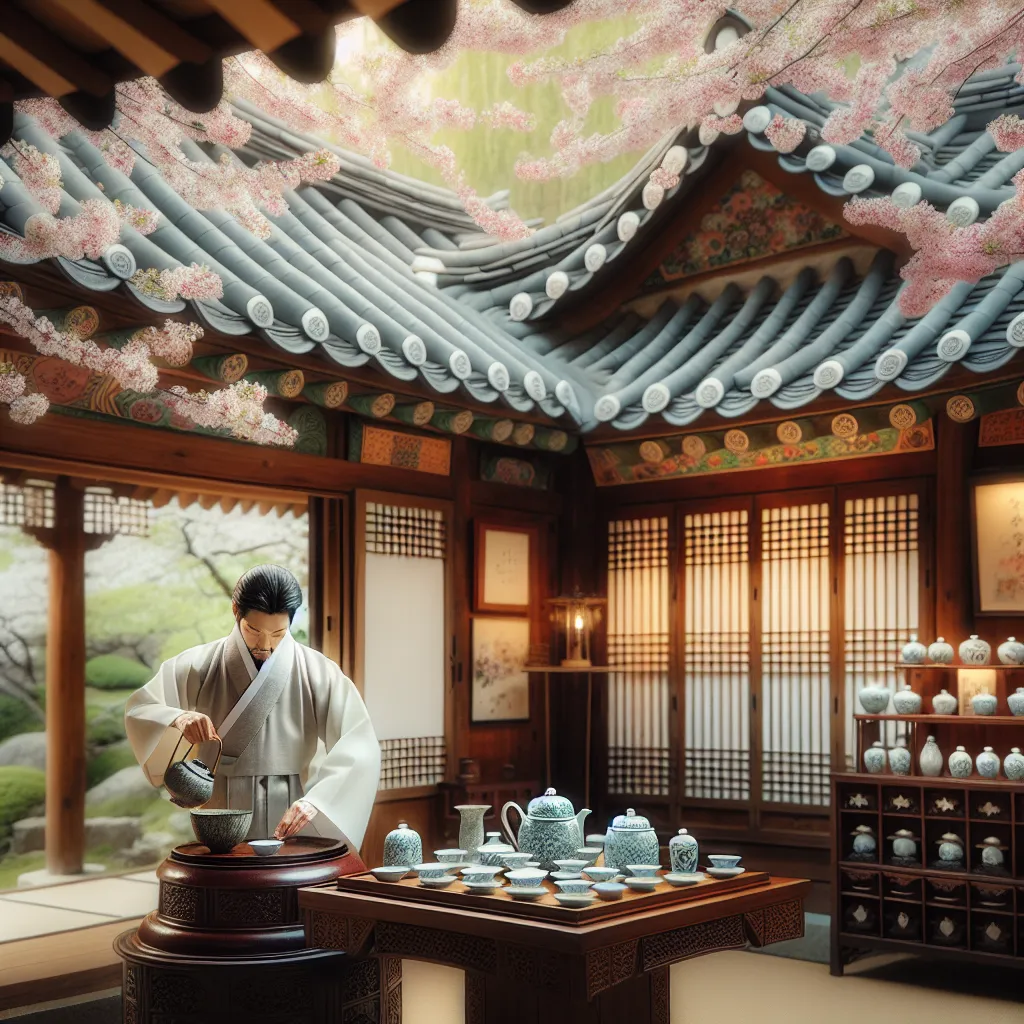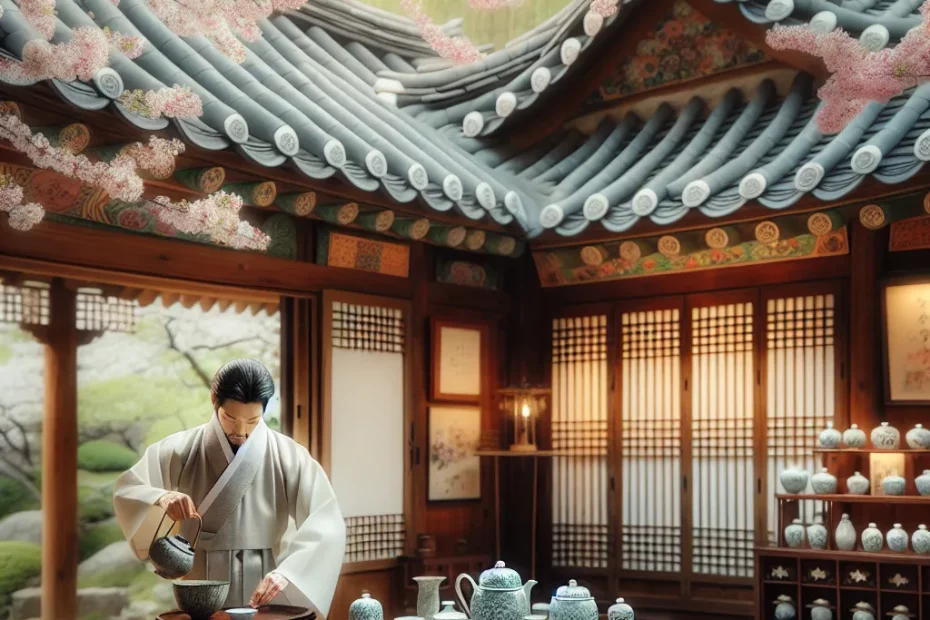The Korean tea ceremony holds a significant cultural importance that reflects the essence of Korean tradition and values. Originating from ancient practices, the ceremony has evolved over centuries, embodying intricate rituals and etiquette that symbolize harmony and respect. Understanding the symbolism and meaning behind each gesture and element in Korean tea culture provides a deeper appreciation for its rich heritage. As modern trends and innovations influence the practice, embracing Korea’s tea culture becomes a way to connect with the past while adapting to the present. Embracing the Korean tea ceremony is not just about enjoying a cup of tea, but about immersing oneself in a centuries-old tradition that continues to shape Korean identity and values.

The Origin and History of Korean Tea Ceremony
The Korean tea ceremony, known as Darye (다례), has a rich history dating back to ancient times. It originated in the Goryeo Dynasty (918-1392) and flourished during the Joseon Dynasty (1392-1910). 🍵
Tea Culture in the Goryeo Dynasty
During the Goryeo Dynasty, tea culture was introduced to Korea by Buddhist monks who brought tea seeds from China. The practice of tea drinking spread among the aristocracy and scholars, leading to the development of unique Korean tea customs and rituals. 🌿
Formalization in the Joseon Dynasty
In the Joseon Dynasty, the Korean tea ceremony became more formalized and structured, with specific rules and etiquette governing the preparation and serving of tea. Tea became an integral part of Korean culture, influencing art, literature, and philosophy. 📜
Contributions of Cho-ui
One of the most significant contributions to the Korean tea ceremony was made by the scholar and tea master Cho-ui (1786-1866). He emphasized the importance of mindfulness and simplicity in tea preparation, laying the foundation for the modern Korean tea ceremony as we know it today. ☯️
Throughout history, the Korean tea ceremony has evolved and adapted to changing social and cultural landscapes, but its core principles of harmony, respect, and tranquility have remained constant. Today, the Korean tea ceremony continues to be practiced and celebrated as a cultural heritage that embodies the essence of Korean identity. 🌸
By exploring the origin and history of the Korean tea ceremony, we gain a deeper appreciation for the traditions and values that have shaped Korean tea culture over centuries. Let us embrace and honor the legacy of Darye, a timeless art form that reflects the beauty and grace of Korean heritage. 🍃
The Rituals and Etiquette of Korean Tea Ceremony
In the realm of Korean traditional culture, the art of tea ceremony holds a revered position, embodying grace, harmony, and respect. The rituals and etiquette observed in Korean tea ceremonies are not merely formalities, but a profound expression of cultural values and aesthetics. Let’s delve into the intricate world of Korean tea ceremony and explore the rich tapestry of rituals and etiquette that define this time-honored tradition! 🍵✨
The Concept of “Dado” (다도)
At the heart of Korean tea ceremony lies the concept of “dado” (다도), which encapsulates the principles of etiquette, mindfulness, and spiritual connection. From the meticulous preparation of the tea utensils to the graceful movements of the host, every aspect of the ceremony is imbued with meaning and symbolism. Each gesture, each sip of tea, is a reflection of respect for the guests, the tea, and the moment itself. 🌿🌸
The Ritual of “Sori” (소리)
One of the key rituals in Korean tea ceremony is the washing of the tea utensils, known as “sori” (소리). This act symbolizes purification and mindfulness, as the host cleanses the utensils with precision and care. The rhythmic sound of water flowing and utensils gently touching creates a meditative atmosphere, inviting guests to immerse themselves in the present moment. Through sori, participants cultivate a sense of tranquility and focus, preparing themselves for the tea-drinking experience. 🌊🫖
The Concept of “Jeong” (정)
Another essential aspect of Korean tea ceremony etiquette is the concept of “jeong” (정), which conveys a deep sense of affection, consideration, and empathy towards others. The host demonstrates jeong by attentively serving tea to each guest, anticipating their needs, and creating a warm and welcoming atmosphere. This spirit of jeong fosters harmonious relationships and fosters a sense of community among participants, transcending mere social interactions to create lasting bonds. ❤️🍃
The Role of the Host
In Korean tea ceremony, the role of the host is pivotal, embodying the values of humility, grace, and generosity. The host’s demeanor, movements, and words are carefully orchestrated to create a sense of harmony and balance in the space. Through their actions, the host guides the guests on a journey of sensory delight, spiritual contemplation, and cultural appreciation. The exchange of tea becomes a profound dialogue, a silent communication that transcends language and unites hearts. ☕🌟
As we immerse ourselves in the rituals and etiquette of Korean tea ceremony, we not only partake in a sensory experience but also connect with a centuries-old tradition that celebrates mindfulness, harmony, and cultural heritage. Let us embrace the beauty of Korean tea ceremony, savoring each moment, each sip, as we honor the past and create meaningful memories for the future. 🍵🌿✨
Symbolism and Meaning in Korean Tea Culture
In Korean tea culture, every aspect of the tea ceremony holds deep symbolism and meaning, reflecting centuries-old traditions and values. From the preparation of the tea to the way it is served, each gesture and tool used in the ceremony carries significance that goes beyond the simple act of drinking tea.
Tea Preparation
The way tea is prepared in Korean tea culture is a ritual in itself. The meticulous process of washing the teaware, measuring the tea leaves, and brewing the tea is a symbol of respect and mindfulness. It represents the importance of being present in the moment and appreciating the simple pleasures of life.
Tea Leaves
The type of tea leaves used in Korean tea ceremonies also conveys meaning. For example, green tea is often chosen for its purity and simplicity, while floral teas may be selected for their delicate fragrance and beauty. The choice of tea leaves can reflect the mood of the ceremony and the intentions of the host.
Teaware
The teaware used in Korean tea ceremonies is not just functional but also symbolic. Each piece, from the teapot to the cups, is carefully selected for its aesthetic value and cultural significance. The design and material of the teaware can represent elements of nature or historical motifs, adding layers of meaning to the ceremony.
Etiquette
Etiquette plays a crucial role in Korean tea culture, guiding the interactions between the host and guests. From the way tea is poured to the way cups are held, every gesture is steeped in tradition and respect. Etiquette in the tea ceremony emphasizes harmony, humility, and gratitude.
Nature and Harmony
Central to Korean tea culture is the idea of harmony with nature. The tea ceremony often takes place in a tranquil setting, surrounded by natural elements like flowers, rocks, and water. This connection to nature is a reminder of our place in the larger world and the importance of living in balance with the environment.
Spiritual Connection
Beyond the physical act of drinking tea, the tea ceremony in Korea is also a spiritual practice. It offers a moment of reflection and meditation, allowing participants to find peace and clarity in the midst of a busy world. The act of sharing tea creates a bond between individuals and fosters a sense of community.
In conclusion, Korean tea culture is not just about drinking tea; it is a rich tapestry of symbolism, meaning, and tradition. Each element of the tea ceremony is carefully chosen to create a holistic experience that nourishes the body, mind, and spirit. By embracing Korea’s tea culture, we can learn valuable lessons about mindfulness, respect, and connection to the world around us.
Modern Trends and Innovations in Korean Tea Ceremony
In recent years, the Korean tea ceremony has experienced a renaissance, blending traditional practices with modern innovations to appeal to a wider audience. This fusion of old and new has brought about exciting trends in the world of Korean tea culture, captivating enthusiasts and newcomers alike. Let’s delve into some of the cutting-edge developments that are shaping the landscape of the Korean tea ceremony today!
The Rise of Tea Pairing Experiences
One notable trend is the rise of tea pairing experiences, where different types of Korean teas are expertly matched with complementary snacks or desserts. This sensory journey not only enhances the flavors of the tea but also provides a holistic experience for participants. Imagine savoring a delicate green tea alongside a sweet rice cake, creating a harmonious balance of tastes and textures that dance on your palate. It’s a true feast for the senses!
Incorporation of Technology into the Tea Ceremony
Another innovative trend is the incorporation of technology into the tea ceremony. From virtual tea tasting sessions to online tea brewing classes, technology has made the ancient practice more accessible to a global audience. Through high-definition video streams and interactive platforms, tea enthusiasts from around the world can now partake in traditional Korean tea ceremonies from the comfort of their homes. The marriage of technology and tradition has truly revolutionized the way we experience Korean tea culture.
Sustainability Initiatives in Korean Tea Ceremonies
Furthermore, sustainability has become a key focus in modern Korean tea ceremonies. With an increasing awareness of environmental issues, tea artisans are embracing eco-friendly practices in tea cultivation and production. From organic farming methods to biodegradable packaging, the tea industry is making strides towards a more sustainable future. By prioritizing environmental conservation, Korean tea ceremonies are not only preserving tradition but also contributing to a greener planet for future generations.
Tea Meditation Practices
In addition, the concept of tea meditation has gained popularity in recent years, offering a tranquil escape from the hustle and bustle of modern life. Through mindful tea drinking practices, participants can cultivate a sense of inner peace and mindfulness. By focusing on the present moment and savoring each sip of tea, individuals can find solace in the simple act of brewing and drinking tea. It’s a therapeutic experience that nourishes both the body and soul.
In conclusion, the Korean tea ceremony continues to evolve and adapt to the changing times, embracing modern trends and innovations while staying true to its rich cultural heritage. From tea pairing experiences to technological advancements, sustainability initiatives to tea meditation practices, the Korean tea ceremony is a vibrant tapestry of tradition and innovation. As we raise our teacups to the future, let us toast to the enduring legacy of Korean tea culture and the endless possibilities that lie ahead! 🍵✨
The Korean tea ceremony holds a deep cultural significance that reflects the country’s rich history and traditions. Through centuries-old rituals and etiquette, the ceremony embodies respect, harmony, and mindfulness. Each gesture and movement in the ceremony carries symbolic meaning, connecting participants to nature, spirituality, and community. As Korea embraces modernization, the tea ceremony continues to evolve, blending tradition with innovation. By preserving and promoting the Korean tea culture, we honor our heritage and pass down invaluable wisdom to future generations. Embracing the Korean tea ceremony is not just about enjoying a cup of tea; it is a profound experience that enriches the mind, body, and soul, fostering a deeper appreciation for Korean culture and history. Let us continue to cherish and uphold this timeless tradition, celebrating the art of tea with reverence and gratitude.
